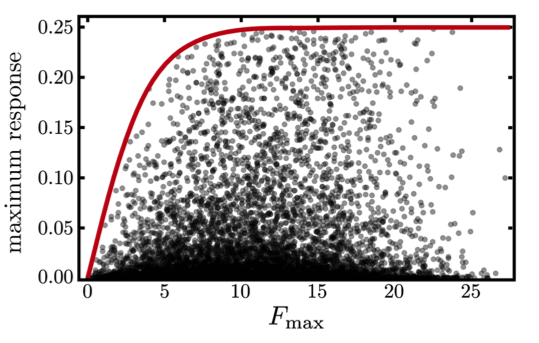Research
Nonequilibrium Response and Biochemical Sensitivity
One of the most basic ways we learn about a physical system is by observing how it responds to small perturbations: from material properties – like elasticity and conductivity – to the effectiveness of biomolecular function – including, biochemical sensing, molecular discrimination, and gene regulation. We have been developing equalities and inequalities, akin to the fluctuation-dissipation theorem, that capture how nonequilibrium driving shapes response and enhances sensitivity in living and nonliving systems.
Nonequilibrium Fluctuations
Today, cutting-edge technology allows us to access, manipulate, and build incredibly small engines, from the molecular motors operating inside cells to the artificial molecular machines they inspire. At such small scales, the world is very different from our everyday experience: fluctuations dominant and inertia is irrelevant. Using tools of stochastic thermodynamics and fluctuation theorems, we have been working to understand how energy dissipation can be used to modulate those fluctuations. We have recently shown that large and rare fluctuations are constrained by the energy dissipation throughout the system. I envision this fundamental relation will serve as a guiding design principle for the operation of nanoscale devices, both artificial and natural.
Estimating dissipation in living organisms
Life is inherently out of equilibrium, consuming energy at the smallest scales to drive useful motion at larger scales. Measuring this dissipation, however, is quite challenging. Using notions of stochastic thermodynamics we can ascertain the nonequilibrium dissipation powering life simply from passive measurements of the irreversibility of fluctuations. Thus, by monitoring living systems across scales, we can then begin to piece together how they use energy to function at every scale.
 Scale invariance in bacterial range expansions
Scale invariance in bacterial range expansions
The ecology of bacterial species can change dramatically when they are allowed to grow out into space. Remarkably, such bacterial range expansions can be described at long times and on large length scales with a well-known reaction-diffusion equation – the Fisher-Kolmogorov equation — that displays a nonequilibrium phase transition from an active to absorbing state within the directed percolation universality class. Simple theoretical models, however, ignore the fluctuations in the growing surface. Recently, we have performed a renormalization group analysis of directed percolation coupled to the Kardar-Parisi-Zhang equation for surface growth in order to unpack the phenomenology of this nonequilibrium phase transition. This coupling of surface fluctuations to ecological/evolutionary dynamics underpins some of the dramatic behavior seen in bacterial range expansions.
Past Research Projects
Information Thermodynamics
Feedback is a powerful tool, allowing one to use microscopic knowledge of a system to control it. With the recent advances in our ability to interrogate and modify the dynamics of mesoscopic systems, assessing the energetic constraints of such control is paramount. By developing a new fluctuation theorem, I have shown that in the presence of feedback the second law of thermodynamics is modified by the inclusion of a term measuring the information gained in a measurement. This information is a thermodynamic resource allowing one to enhance the energetic output of thermodynamic engines using feedback. It also constrains the energetic requirements of measurement and sensing. Such insights hold promise for revealing the minimal requirements for sensing, measurement, and decision making in organisms, such as bacteria, that must monitor and respond to their environment.
Quantum Thermodynamics
Quantum coherences are a unique thermodynamic resource, offering the possibility of quantum-boosted thermodynamic engines. In trying to unravel the role of quantum effects in thermodynamics, I have been working to develop a quantum stochastic thermodynamics that consistently describes quantum fluctuations of thermodynamic quantities — such as work, heat and entropy — along individual quantum trajectories. I have applied this technique to study work and heat fluctuations in quantum systems coupled to thermal environments as well as more general environments modeled as completely-postiive trace-preserving maps. This work reveals that quantum coherences manifest themselves as a novel thermodynamic force that can be exploited as an alternative free energy source.


